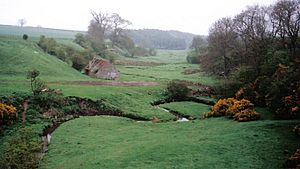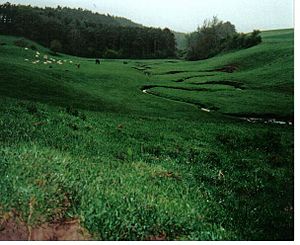Cessford Burn facts for kids
The Cessford Burn is a small stream in Scotland. It flows into the Kale Water, which then joins the River Teviot. Finally, the Teviot meets the mighty River Tweed near Kelso.
Contents
A Glimpse into History: The Old Farmstead
Near the Cessford Burn, you can find the remains of an old farm. This farm was once connected to Cessford Castle. It is located in what was historically Roxburghshire, now part of the Scottish Borders area. The farm lies between the towns of Kelso and Morebattle, in the parish of Eckford.
What Was the Farm Like?
You can still see the old foundation stones of the buildings on the north side of the Cessford Burn. Long ago, there were seven small, thatched cottages here. These cottages were called shiels. Families lived in these shiels, including the farm manager, the shepherd, and the ploughman.
Why Was the Farm Attacked?
Sadly, this farm was attacked and burned down many times. This happened during conflicts between Scotland and England, especially along the border. For example, the English army, led by the Earl of Surrey, burned it in May 1523. It was also destroyed by the Earl of Hertford in 1545. These attacks were part of a period called the Rough Wooing. This was when Henry VIII of England tried to force Mary, Queen of Scots to marry his son.
Who Lived at the Farm?
The families living at the Cessford Burn farm worked for the Kers of Cessford. The Kers were a powerful family, later known as the Dukes of Roxburghe. Scottish kings, like James I of Scotland and James II of Scotland, gave them the right to own these lands. This included Kerr Castle (also known as Cessford Castle) and the farm buildings.
Cessford Castle and Village
Cessford Castle is now in ruins. It stands on a ridge across from the Cessford Burn, on the south side. There was also a small village, or "castelton," near the castle. It was just outside the castle's north gate.
What Happened to the Village?
The village of Cessford no longer exists today. However, old maps and aerial photos show where it once stood. For example, Matthew Stobie's map from 1770 shows the village next to the castle, towards Morebattle. About 140 people lived in Cessford village during those times.
Hidden Gems Along the Burn
Along the peaceful banks of the Cessford Burn, there's a special place called Habbie Kerr's cave. Local people used this cave for safety and shelter for many centuries.
The Crow Tree
Just south of Cessford Castle, there used to be a very old ash tree. It was known as the "Crow Tree." In the past, quick and harsh justice, sometimes called "Jeddart Justice," was carried out there.
The Nisbet Family at Cessford Burn
A branch of the old Scottish Nisbet family worked as shepherds at Cessford Burn. They lived there from about 1665. However, they later moved to Canada and New York in 1822. This happened because many small farms in the Scottish Borders were being combined into larger ones during the late 1700s. You can also learn more about the Nisbet family in Nisbet, Roxburghshire.



